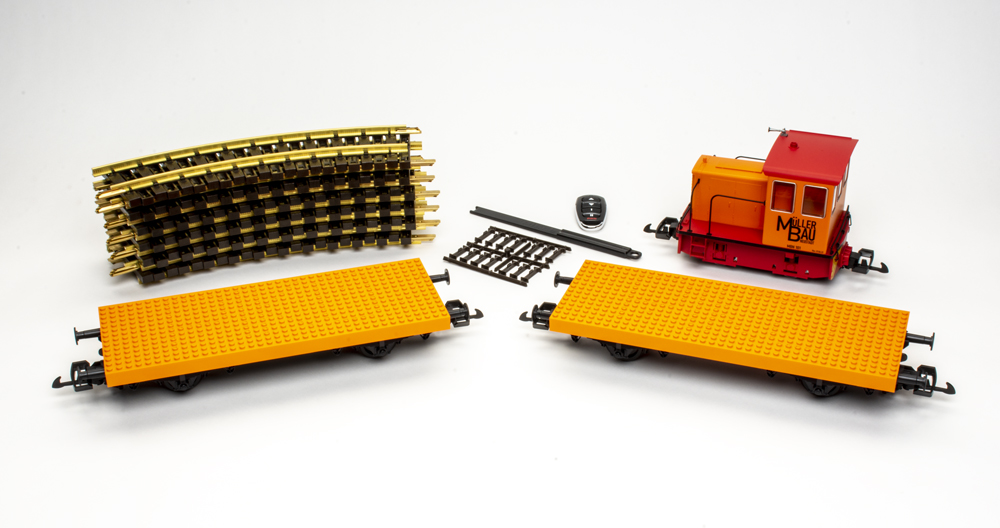
PIKO America Building Block R/C Starter set: An ongoing question in the hobby is “How do we get new people into model railroading?” PIKO America offers a clever solution with its Building Block R/C Starter Set (No. 37155). The indoor/outdoor set includes a battery-operated 1:24-proportion General Electric (GE) 25-ton diesel locomotives, two flatcars, a 51” diameter circle of track, track clips, an R/C pocket remote for the switcher, and an uncoupling wand. All you need to supply are batteries, building blocks, and your imagination.
General Electric 25-ton diesel
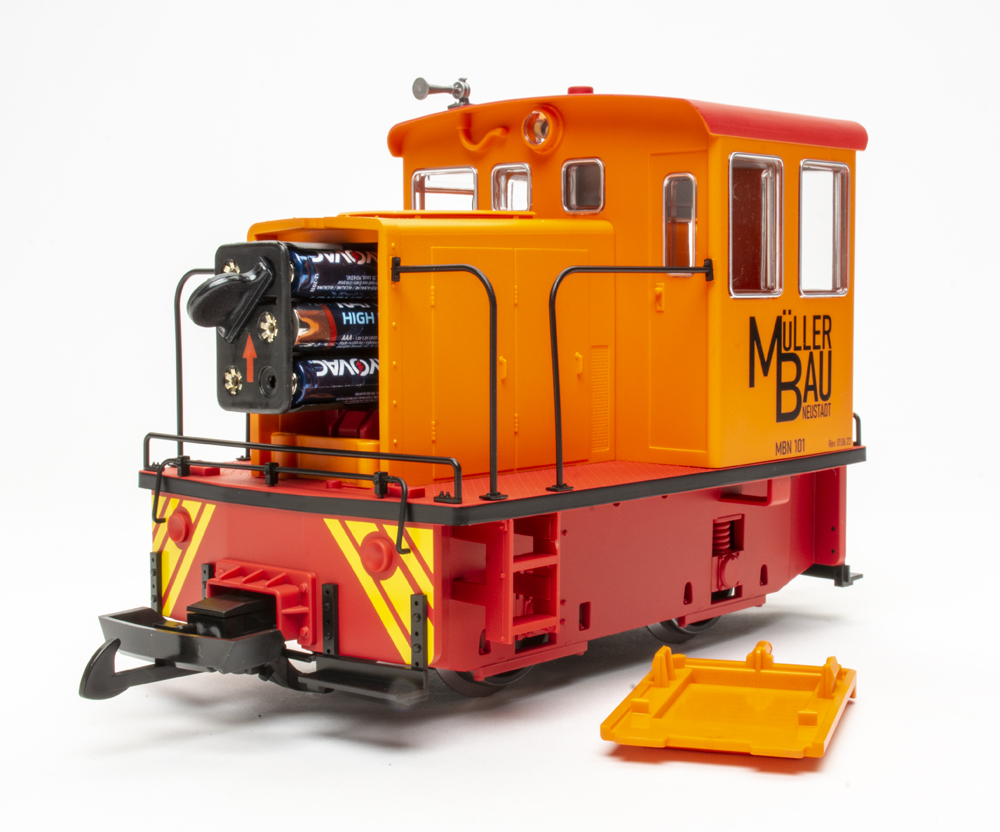
The set is neatly packed in a 15” x 23” box with a handle, making it easy to transport and store. Inside are four smaller boxes containing the locomotive and related accessories, flatcars, track, and an uncoupling wand and track clips.
The train is powered by a GE 25-ton diesel locomotive, detailed to match mid- and late-production prototypes. See the Spring 2019 issue of Garden Railways for a review of this model.
The four-wheel locomotive has directional light-emitting-diode headlights and a cab interior light; molded door hinges, handles, and screens on the hood; separate, factory-applied handrails and uncoupling levers; and clear window glazing with silver trim. The cab window on the engineer’s side is open. Modeler-installed parts include a single-chime air horn, bell, and footboards. Adapters and screws for replacing the hook-and-loop couplers with Kadee knuckle couplers are also supplied.
The locomotive requires six AAA batteries, not included. To install the batteries, gently pull the radiator section forward two release the two tabs that fit inside the hood. Then pull up to release the tabs that seat in slots on the chassis.
With the radiator panel removed, press the battery retainer clip (below the red arrow) down. Then pull the battery holder out using the handle. Install the batteries per the instructions. Reverse the process for reassembly.
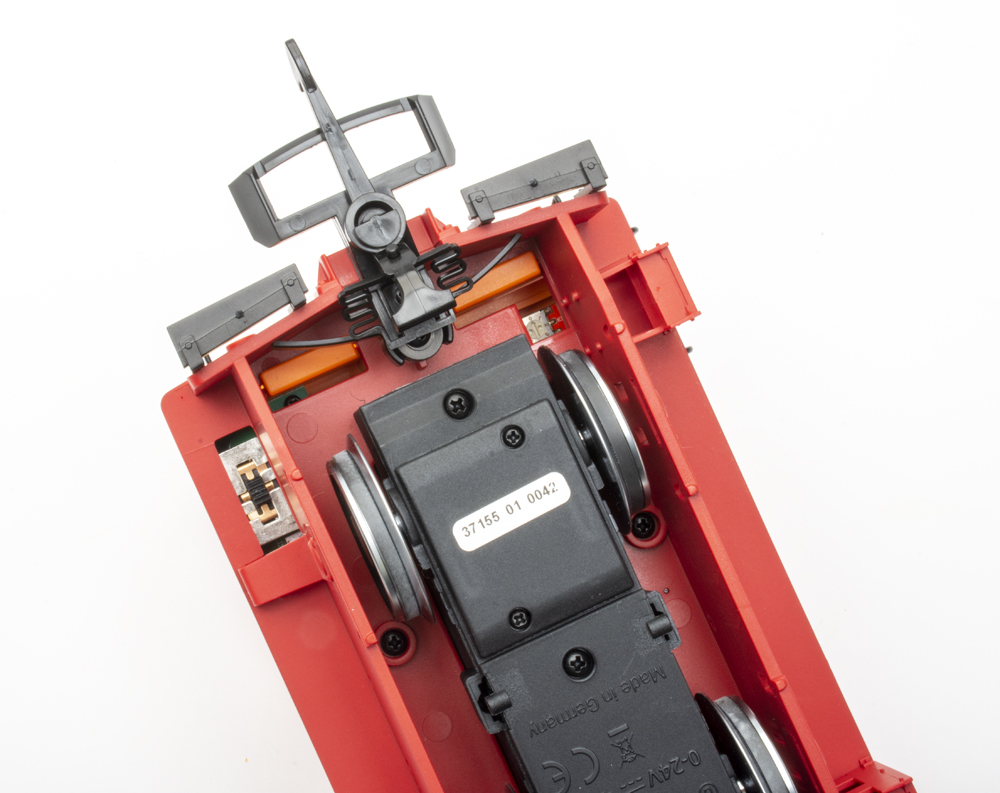
The battery-powered locomotive has traction tires on all four wheels. To run the locomotive, first move the slider switch below the cab on the brakeman’s to the reverse position. This will illuminate the cab interior light. Then, with the pocket R/C remote, use the up and down buttons to control the engine. Each press of the button increases (up arrow) or decreases (down arrow) the speed. Pressing the up and down arrow buttons simultaneously activates an emergency stop, which also turns the headlight off. The keys with Roman numerals I and II aren’t used on this version of the remote.
The pocket remote, which has a range of more than 80 feet, has eight selectable channels (0 through 7). From the factory, the remote and locomotive are set to 0. To change the channel on the remote, remove the round cover on the back and use a flat-bladed screwdriver to turn the rotary DIP switch to the desired number. The switch on the locomotive is behind the rear wheel on the engineer’s side.
Two flatcars
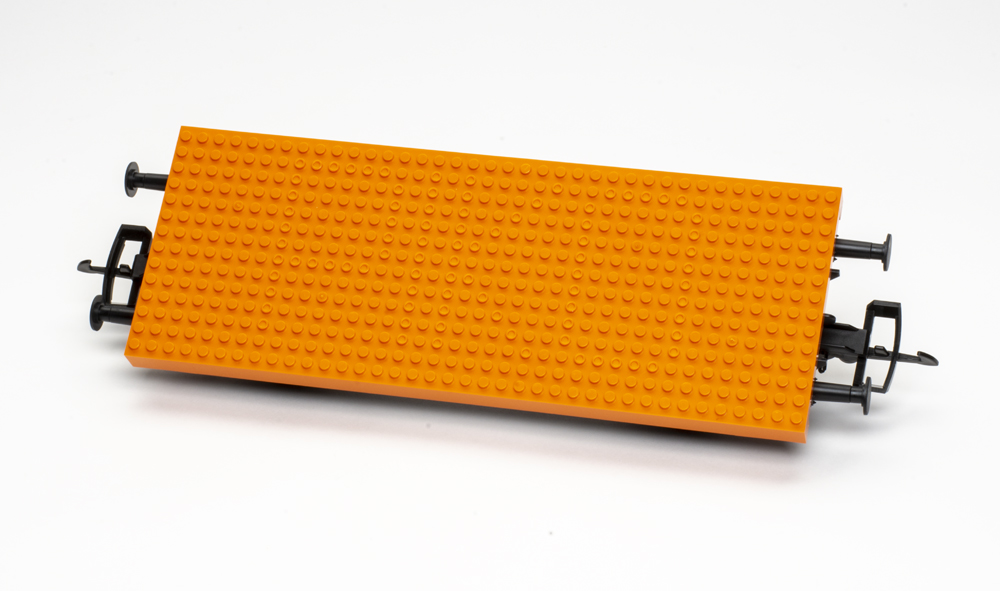
The flatcars feature a 4-1/2” x 12” deck molded in orange plastic. Most of the 532 studs are solid. Those that are hollow in the center spell PIKO. Fun! The flatcar deck is compatible with LEGO, DUPLO, and other popular brands of plastic building blocks.
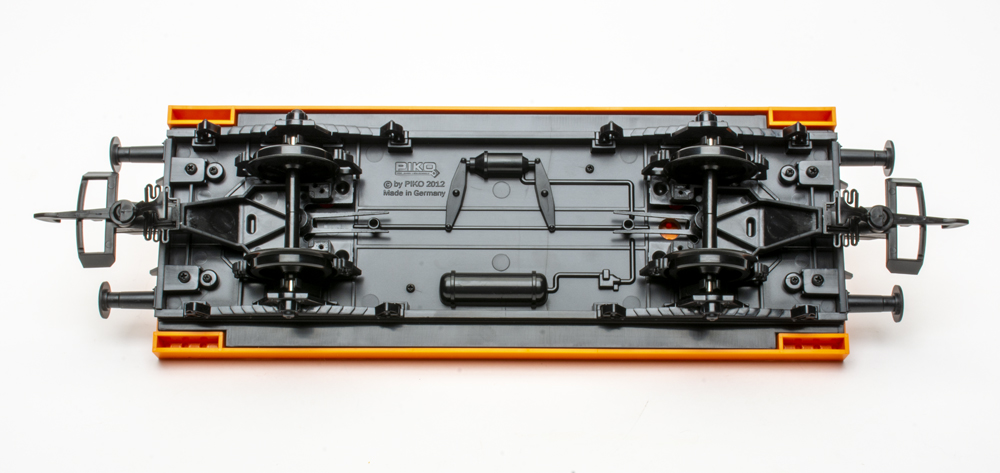
The underbody is molded in black plastic and secured to the deck with six screws. The main truck frames are held in place with a screw located under the axle. Plastic centering springs extend from the rear of the truck frame to a short plastic post. Also packaged with the cars are modeler-installed hook-and-loop couplers.
The flatcars ride on three-piece wheelsets consisting of two plastic wheel stubs mounted on a metal axle. The brake appliances, levers, and piping are molded. Freestanding parts include four press-fit wheel covers and two screw-mounted end beams. The buffers are factory applied.
Let’s run some trains!
Familiar with the equipment, it was time to get building. I set up the 12 pieces of R1 track on our dining room floor. The track features virgin brass rail; plastic ties with wood grain, tie plate, and spike detail; and two factory-installed rail joiners per section. If you plan on a permanent installation, two ties per section have nail holes. Ideas for expanding the set beyond the circle are printed on the back of the box.
Since our setup was temporary, I used the track clips to keep the sections from pulling apart. The 14 clips are attached to a sprue. I was able to easily remove them with sprue cutters. Then I placed them in the notches on the bottom of the end ties.
While I was setting up the track, I gave my 11-year-old son (a huge LEGO fan) and my 9-year-old a flatcar to build on. For a few hours I could hear the rattle of LEGO pieces coming from their rooms. Then Albert and Rosalie returned to show me their creations. My son populated his flatcar deck with parts from his LEGO City sets and items from the manufacturer’s Star Wars product range. My daughter constructed a rolling humane society on her flatcar using parts from her LEGO Friends sets.
We then placed the locomotive and finished cars on the circle of track. After a quick crash course on the R/C pocket remote, I turned the controls over to my wife and kids, who all enjoyed running trains. Before long building block structures were showing up trackside.
Oh, from one parent to another, the battery-powered engine doesn’t need to be on the tracks to run. If you see a locomotive chasing your pet, or the other way around, don’t say I didn’t warn you!
Anytime fun
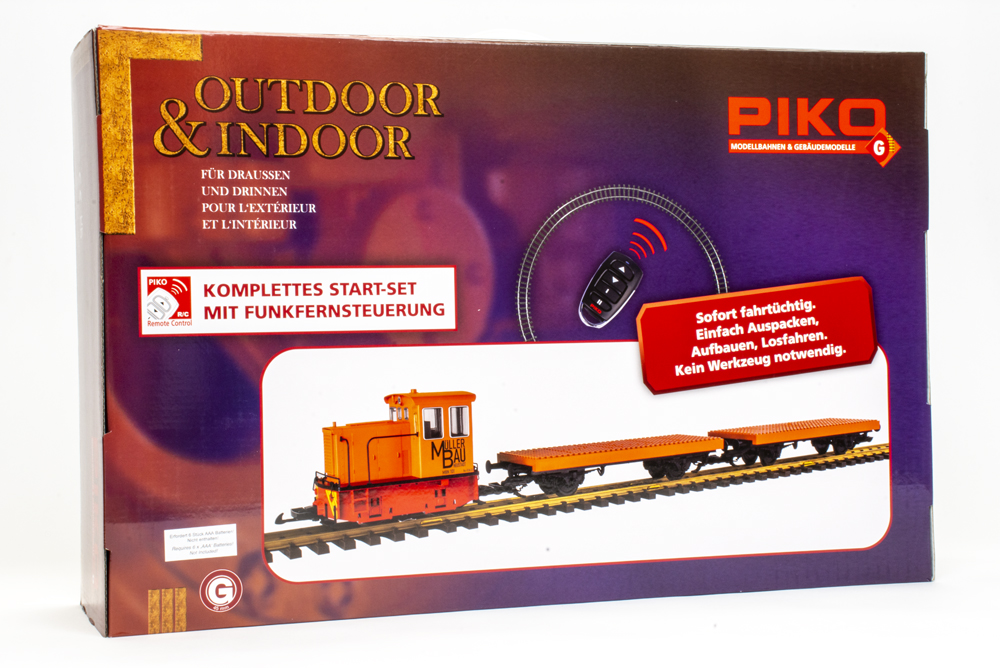
If you’re looking for a way engage the next generation in model railroaders, or you’re in search of a screen-free source of entertainment for your kids, check out the PIKO America Building Block R/C Starter Set. The locomotive and cars are sturdy and will withstand normal handling from kids (and adults) of all ages. The set is also designed for indoor and outdoor use, so it’s a great way to encourage play regardless of the weather or time of year. And when your crew is done running trains for the day, the set can be neatly packed up and stored until next time.
Manufacturer
PIKO America LLC
4610 Alvarado Canyon Rd., Ste. 5
San Diego, CA 92120
piko-america.com
Price: $529.99
Features
- 12 pieces of R1 curved track
- General Electric 25-ton diesel locomotive (battery powered with R/C pocket remote)
- R/C pocket remote
- Track clips
- Two flatcars with building block studs on deck
- Uncoupling bar













